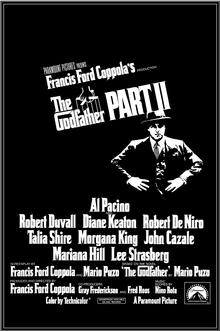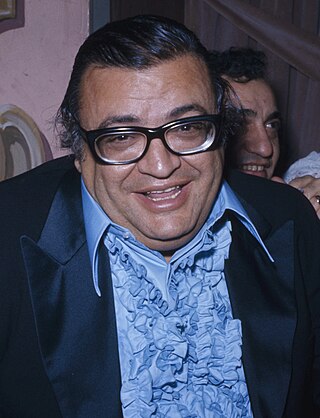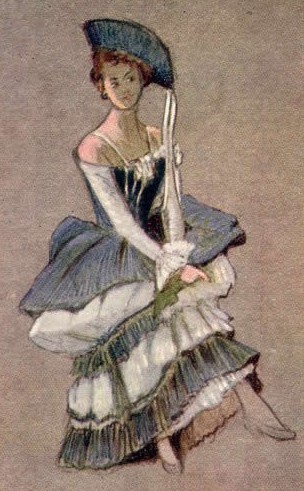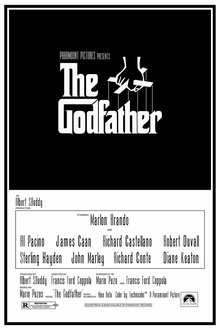
Francis Ford Coppola is an American film director, producer, and screenwriter. He is considered one of the leading figures of the New Hollywood film movement of the 1960s and 1970s and is widely considered one of the greatest directors of all time. Coppola is the recipient of five Academy Awards, six Golden Globe Awards, two Palmes d'Or, and a British Academy Film Award (BAFTA).

The Godfather Part II is a 1974 American epic crime film. The film is produced and directed by Francis Ford Coppola, loosely based on the 1969 novel The Godfather by Mario Puzo, who co-wrote the screenplay with Coppola. It is both a sequel and a prequel to the 1972 film The Godfather, presenting parallel dramas: one picks up the 1958 story of Michael Corleone, the new Don of the Corleone family, protecting the family business in the aftermath of an attempt on his life; the prequel covers the journey of his father, Vito Corleone, from his Sicilian childhood to the founding of his family enterprise in New York City. The ensemble cast also features Robert Duvall, Diane Keaton, Talia Shire, Morgana King, John Cazale, Marianna Hill, and Lee Strasberg.

Mario Francis Puzo was an American author and screenwriter. He wrote crime novels about the Italian-American Mafia and Sicilian Mafia, most notably The Godfather (1969), which he later co-adapted into a film trilogy directed by Francis Ford Coppola. He received the Academy Award for Best Adapted Screenplay for the first film in 1972 and for Part II in 1974. Puzo also wrote the original screenplay for the 1978 Superman film and its 1980 sequel. His final novel, The Family, was released posthumously in 2001.

The Godfather Part III is a 1990 American epic crime film produced and directed by Francis Ford Coppola from the screenplay co-written with Mario Puzo. The film stars Al Pacino, Diane Keaton, Talia Shire, Andy García, Eli Wallach, Joe Mantegna, Bridget Fonda, George Hamilton, and Sofia Coppola. It is the third and final installment in The Godfather trilogy. A sequel to The Godfather (1972) and The Godfather Part II (1974), it concludes the fictional story of Michael Corleone, the patriarch of the Corleone family who attempts to legitimize his criminal empire. The film also includes fictionalized accounts of two real-life events: the 1978 death of Pope John Paul I and the Papal banking scandal of 1981–1982, both linked to Michael Corleone's business affairs.

Stage management is a broad field that is generally defined as the practice of organization and coordination of an event or theatrical production. Stage management may encompass a variety of activities including overseeing of the rehearsal process and coordinating communications among various production teams and personnel. Stage management requires a general understanding of all aspects of production and provides complete organization to ensure the process runs smoothly and efficiently.

In theatre, a lighting designer works with the director, choreographer, set designer, costume designer, and sound designer to create the lighting, atmosphere, and time of day for the production in response to the text while keeping in mind issues of visibility, safety, and cost. The LD also works closely with the stage manager or show control programming, if show control systems are used in that production. Outside stage lighting, the job of a lighting designer can be much more diverse, and they can be found working on rock and pop tours, corporate launches, art installations, or lighting effects at sporting events.

The Cotton Club is a 1984 American musical crime drama film co-written and directed by Francis Ford Coppola and based on James Haskins' 1977 book of the same name. The story centers on the Cotton Club, a Harlem jazz club in the 1930s. The film stars Richard Gere, Gregory Hines, Diane Lane and Lonette McKee, with Bob Hoskins, James Remar, Nicolas Cage, Allen Garfield, Gwen Verdon, Fred Gwynne and Laurence Fishburne in supporting roles.

John Holland Cazale was an American actor. He appeared in five films over seven years: The Godfather (1972), The Conversation (1974), The Godfather Part II (1974), Dog Day Afternoon (1975), and The Deer Hunter (1978), each of which was nominated as Best Picture at their respective Academy Awards. Cazale started as a theater actor in New York City, ranging from regional, to off-Broadway, to Broadway acting alongside Al Pacino, Meryl Streep, and Sam Waterston. Cazale soon became one of Hollywood's premier character actors, starting with his role as the doomed, weak-minded Fredo Corleone opposite longtime friend Al Pacino in Francis Ford Coppola's film The Godfather and its 1974 sequel, as well as Sidney Lumet's Dog Day Afternoon. In 1977, Cazale was diagnosed with lung cancer, but he chose to complete his role in The Deer Hunter. He died shortly after, in New York City on March 13, 1978.

Costume design is the creation of clothing for the overall appearance of a character or performer. Costume may refer to the style of dress particular to a nation, a social class, or a period. In many cases, it may contribute to the fullness of the artistic, visual world which is unique to a particular theatrical or cinematic production. The most basic designs are produced to denote status, provide protection or modesty, or provide visual interest to a character. Costumes may be for a theater, cinema, musical performance, cosplay, parties, or other events. Costume design should not be confused with costume coordination which merely involves altering existing clothing, although both create stage clothes.

In a theatre, the prompt corner or prompt box is the place where the prompter—usually the stage manager in the US or deputy stage manager in the UK—stands in order to coordinate the performance and to remind performers of their lines when required. It is traditionally located at stage left.

The light board operator, is the electrician who operates and may even program the light board. They are considered part of the "Electrics" Department or LX Department. All non-design elements of lighting will be handled by the LX Department, i.e. electricians. Light board operators mainly are responsible for decoding the light designer's ideas from paper to opening night ready. In some cases, the light board operator is also the light designer.

The Godfather is a 1972 American epic gangster film directed by Francis Ford Coppola, who co-wrote the screenplay with Mario Puzo, based on Puzo's best-selling 1969 novel of the same title. The film stars an ensemble cast including Marlon Brando, Al Pacino, James Caan, Richard Castellano, Robert Duvall, Sterling Hayden, John Marley, Richard Conte, and Diane Keaton. It is the first installment in The Godfather trilogy, chronicling the Corleone family under patriarch Vito Corleone (Brando) from 1945 to 1955. It focuses on the transformation of his youngest son, Michael Corleone (Pacino), from reluctant family outsider to ruthless mafia boss.
The technical rehearsal or tech rehearsal is a rehearsal that focuses on the technological aspects of the performance, in theatrical, musical, and filmed entertainment.
A theatrical technician, also known as a theatrical tech, theatre technician, or theatre tech is a person who operates technical equipment and systems in the performing arts and entertainment industry. In contrast to performers, this broad category contains all "unseen" theatrical personnel who practice stagecraft and are responsible for the logistic and production-related aspects of a performance including designers, operators, and supervisors.
The Godfather is a trilogy of American crime films directed by Francis Ford Coppola inspired by the 1969 novel of the same name by Italian American author Mario Puzo. The films follow the trials of the fictional Italian American mafia Corleone family whose patriarch, Vito Corleone, rises to be a major figure in American organized crime. His youngest son, Michael Corleone, becomes his successor. The films were distributed by Paramount Pictures and released in 1972, 1974, and 1990. The series achieved success at the box office, with the films earning between $430 and $517 million worldwide. The Godfather and The Godfather Part II are both seen by many as two of the greatest films of all time. The series is heavily awarded, winning 9 out of 28 total Academy Award nominations.
Edward Knight was the prompter of the King's Men, the acting company that performed the plays of William Shakespeare, Ben Jonson, John Fletcher, and other playwrights of Jacobean and Caroline drama.
The following outline is provided as an overview of and topical guide to stagecraft:
John Moore (1814–1893) was a British actor, prompter, and stage manager.
Megalopolis is a 2024 American epic science fiction drama film written, directed, and produced by Francis Ford Coppola. It features an ensemble cast, including Adam Driver, Giancarlo Esposito, Nathalie Emmanuel, Aubrey Plaza, Shia LaBeouf, Jon Voight, Laurence Fishburne, Talia Shire, Jason Schwartzman, Kathryn Hunter, Grace VanderWaal, Chloe Fineman, James Remar, D. B. Sweeney, and Dustin Hoffman. Set in an imagined modern America, it follows Cesar Catilina (Driver), a visionary architect, as he clashes with the corrupt Mayor Franklyn Cicero (Esposito) in determining how to rebuild the metropolis of New Rome after a devastating disaster. The film references the characters involved in the Catilinarian conspiracy of 63 BC, including Catiline and Cicero, in addition to Caesar.













